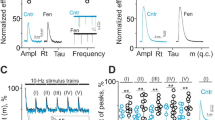Abstract
The purpose of this study was to examine changes in fatty acyl chain composition of major cardiac phospholipids in relation to down-regulation of β-adrenoceptors during various forms of stress or chronic adrenergic stimulation. Analysis of the fatty acid profile of phosphatidylcholine (PC) and phosphatidylethanolamine (PE) in sarcolemma or cardiac muscle membranes showed partial replacement of 18:2n-6 by 20:4n-6 in PC and replacement of both 18:2n-6 and 20:4n-6 by 22:6n-3 in PE during daily administration of epinephrine or norepinephrine for 7 or 15 days, respectively These changes in membrane PC and PE coincided with down-regulation or the decrease in Bmax of β-adrenoceptors during adrenergic stimulation. Cardiac membrane response to other forms of stress or chronic adrenergic stimulation such as neonatal stress, restriction stress or restricted food intake was expressed in the same way, that is replacement of 18:2n-6 by 20:4n-6 in PC and replacement of 18:2n-6 and 20:4n-6 by 22:6n-3 in PE.
Conclusion: Adaptation to stress includes a decrease in the density of binding sites or down-regulation of β-adrenoceptors in sarcolemma synchronized with specific alterations in the fatty acyl chain composition within the membrane bilayer. The changes in the lipid milieu of the membrane may facilitate conformational changes in the transmembrane segment of the receptor forming the ligand binding sites of the β-adrenoceptor.
Similar content being viewed by others
References
Stubbs CD, Smith AD: The modification of mammalian membranepoly-unsaturated fatty acid composition in relation to membrane fluidity and function. Biochim Biophys Acta 779: 89–137, 1984
Gudmundsdóttir A, Gudbjarnason S: Neonatal changes in fatty acid profile of phospholipids in rat heart muscle. Biochim Biophys Acta 752: 284–290, 1983
Emilsson A, Gudbjarnason S: Reversible alterations in fatty acid profile of glycerophospholipids in rat heart muscle induced by repeated norepinephrine administration. Biochim Biophys Acta 750: 1–6, 1983
Benediktsdóttir VE, Gudbjarnason S: Reversible alterations in fatty acid composition of heart muscle membrane phospholipids induced by epinephrine in rats fed different fats. J Lipid Res 29: 765–772, 1988
Gudmundsdóttir E, Benediktsdóttir VE, Gudbjarnason S: Combined effects of age and dietary fat on beta-receptors and Ca-channels in rat hearts. Am J Physiol 260: H66-H72, 1991
Skuladóttir GV, Schiöth HB and Gudbjarnason S: Polyunsaturated fatty acids in heart muscle and alphal-adrenoceptor binding properties. Biochim Biophys Acta 1178: 49–54, 1993
Gudbjarnason S, Benediktsdóttir VE: Coregulation of adrenoceptors and the lipid environment in heart muscle during repeated adrenergic stimulation. J Mol Cell Cardiol 27: 243–251, 1995
Benediktsdottir VE, Skuladóttir GV, Gudbjarnason S: Effects of ageing and adrenergic stimulation on α1- and β-adrenoceptors and phospholipid fatty acids in rat heart. Eur J Pharmacol 289: 419–427, 1995
Chamock JS: Lipids and cardiac arrhythmias. Prog Lipid Res 33: 355–385, 1994
Lamers JMJ, Hartog JM, Verdouw PD, Hulsmann WC: Dietary fatty acids and myocardial function. In: H. Stam and G.J. van der Vusse (eds). Lipid metabolism in the normoxic and ischemic heart. Steinkopff Verlag, Darmstadt, 1986, pp 209–221
McMurchie EJ: Dietary lipids and the regulation of membrane fluidity and function. In: Advances in Membrane fluidity: Physiological regulation of membrane fluidity. Alan R. Liss, Inc., New York, NY: 1988, pp 189–237
Billman GE, Hallaq H, Leaf A: Prevention of ischemia-induced ventricular fibrillation by ω3 fatty acids. Proc Natl Acad Sci (USA) 91: 4427–4430, 1994
Bevan JA, Bevan RD, Shreeve M: Variable receptor affinity hypthesis. FASEB J. 3: 1696–1704, 1989
Balazs T, Arena E, Barron GN: Protection against the cardiotoxic effect of isoproterenol FICI by restricted food intake in rats. Toxicology Appl Pharmacol 21: 237–243, 1972
Mikhail AA, Holland HC: A simplified method of inducing stomach ulcers. J Psychosomatic Res. 9: 343–347, 1966
Strader CD, Sigal IS, Dixon RA: Structural basis of beta-adrenergic receptor function. FASEB J 3: 1825–1832, 1989
Stubbs CD, Ho C, Slater SJ: Increased omega-3 unsaturation induces modifications to bilayer structure that alter membrane protein function. In: H.J. Pownall, A.A. Spector (eds). Proceedings from the Scientific Conference on Omega-3 Fatty Acids in Nutrition, Vascular Biology and Medicine. Am Heart Assoc 1994, pp 132–139
Gudbjarnason S: Dynamics of n-3 and n-6 fatty acids in phospholipids of heart muscle. J Internal Med 225: Suppl 1, 117–128, 1989
Author information
Authors and Affiliations
Rights and permissions
About this article
Cite this article
Gudbjamason, S., Benediktsdottir, V.E. Regulation of β-adrenoceptor properties and the lipid milieu in heart muscle membranes during stress. Mol Cell Biochem 163, 137–143 (1996). https://doi.org/10.1007/BF00408650
Issue Date:
DOI: https://doi.org/10.1007/BF00408650



